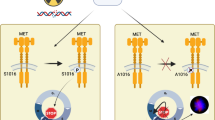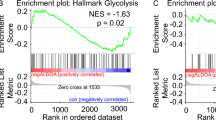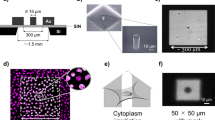Abstract
Nijmegen breakage syndrome (NBS) is characterized by extreme radiation sensitivity, chromosomal instability and cancer1. The phenotypes are similar to those of ataxia telangiectasia mutated (ATM) disease, where there is a deficiency in a protein kinase that is activated by DNA damage, indicating that the Nbs and Atm proteins may participate in common pathways. Here we report that Nbs is specifically phosphorylated in response to γ-radiation, ultraviolet light and exposure to hydroxyurea. Phosphorylation of Nbs mediated by γ-radiation, but not that induced by hydroxyurea or ultraviolet light, was markedly reduced in ATM cells. In vivo, Nbs was phosphorylated on many serine residues, of which S343, S397 and S615 were phosphorylated by Atm in vitro. At least two of these sites were underphosphorylated in ATM cells. Inactivation of these serines by mutation partially abrogated Atm-dependent phosphorylation. Reconstituting NBS cells with a mutant form of Nbs that cannot be phosphorylated at selected, ATM-dependent serine residues led to a specific reduction in clonogenic survival after γ-radiation. Thus, phosphorylation of Nbs by Atm is critical for certain responses of human cells to DNA damage.
This is a preview of subscription content, access via your institution
Access options
Subscribe to this journal
Receive 51 print issues and online access
$199.00 per year
only $3.90 per issue
Buy this article
- Purchase on Springer Link
- Instant access to full article PDF
Prices may be subject to local taxes which are calculated during checkout




Similar content being viewed by others
References
Shiloh, Y. Ataxia-telangiectasia and the Nijmegen Breakage Syndrome—related disorders but genes apart. Annu. Rev. Genet. 31, 635 –662 (1997).
Savitsky, K. et al. A single ataxia telangiectasia gene with a product similar to PI-3 kinase. Science 268, 1749– 1753 (1995).
Banin, S. et al. Enhanced phosphorylation of p53 by ATM in response to DNA damage. Science 281, 1674–1677 (1998).
Canman, C. E. et al. Activation of the ATM kinase by ionizing radiation and phosphorylation of p53. Science 281, 1677– 1679 (1998).
Matsuoka, S., Huang, M. & Elledge, S. J. Linkage of ATM to cell cycle regulation by the Chk2 protein kinase. Science 282, 1893– 1897 (1998).
Brown, A. L. et al. A human Cds1-related kinase that functions downstream of ATM protein in the cellular response to DNA damage. Proc. Natl Acad. Sci. USA 96, 3745–3750 ( 1999).
Cortez, D., Wang, Y., Qin, J. & Elledge, S. J. Requirement of ATM-dependent phosphorylation of Brca1 in the DNA damage response to double-strand breaks. Science 286, 1162– 1166 (1999).
Hoekstra, M. F. Responses to DNA damage and regulation of cell cycle checkpoints by the ATM protein kinase family. Curr. Opin. Genet. Dev. 7, 170–175 (1997).
Sarkaria, J. et al. Inhibition of phosphoinositide 3-kinase related kinases by the radiosensitizing agent wortmannin. Cancer Res. 58, 4375–4382 (1998).
Ziv, Y. et al. Recombinant ATM protein complements the cellular A-T phenotype. Oncogene 15, 159–167 (1997).
Kim, S. -T., Lim, D. -S., Canman, C. E. & Kastan, M. B. Substrate specificities and identification of putative substrates of ATM kinase family members. J. Biol. Chem. 274, 37538 –37543 (1999).
O' Neill, T. et al. Utilization of oriented peptide libraries to identify substrate motifs selected by ATM and DNA-PK. J. Biol. Chem. (in the press).
Wu, X., Petrini, J. H. J., Weaver, D. T., Livingston, D. M. & Chen, J. Independence of Nbs1/Mre11/Rad50 nuclear focus formation and the presence of intact BRCA. Science (in the press).
Ciccone, D. N. et al. Rescue of a telomere length defect of Nijmegen breakage syndrome cells by NBS and Telomerase catalytic subunity. Nature Genet. (submitted).
Stewart, G. et al. The DNA double-strand break repair gene hMRE11 is mutated in individuals with an ataxia-telangiectasia-like disorder. Cell 99, 577–587 ( 1999).
Luo, G. et al. Disruption of mRad50 causes embryonic stem cell lethality, abnormal embryonic development, and sensitivity to ionizing radiation. Proc. Natl Acad. Sci. USA 96, 7376– 7381 (1999).
Yamaguchi-Iwai, Y. et al. Mre11 is essential for the maintenance of chromosomal DNA in vertebrate cells. EMBO J. 18, 6619– 6629 (1999).
Carney, J. P. et al. The hMre11/Rad50 protein complex and Nijmegen breakage syndrome: linkage of double-strand break repair to the cellular DNA damage response. Cell 93, 477–486 (1998).
Paull, T. T. & Gellert, M. Nbs1 potentiates ATP-driven DNA unwinding and endonuclease cleavage by the Mre11/Rad50 complex. Genes Dev. 13, 1276–1288 (1999).
Zhong, Q. et al. Association of BRCA1 with the hRad50-hMre11-p95 complex and the DNA damage response. Science 285, 747– 750 (1999).
Scully, R. et al. Dynamic changes of BRCA1 subnuclear location and phosphorylation state are initiated by DNA damage. Cell 90, 425–435 (1997).
Scully, R. et al. Association of BRCA1 with Rad51 in mitotic and meiotic cells. Cell 88, 265–275 (1997).
Chen, G. et al. Radiation-induced assembly of Rad51 and Rad52 recombination complex requires ATM and c-Abl. J. Biol. Chem. 274, 12748–12752 (1999).
Moynahan, M. E., Chiu, J. W., Koller, B. H. & Jasin, M. Brca1 controls homology-directed DNA repair. Mol. Cell 4, 511–518 (1999).
Scully, R. et al. Genetic analysis of BRCA1 function in a defined tumor cell line. Mol. Cell 4, 1093– 1099 (1999).
Seemanova, E. An increased risk for malignant neoplasms in heterozygotes for a syndrome of microcephaly, normal intelligence, growth retardation, remarkable facies, immunodeficiency and chromosomal instability. Mutat. Res. 238, 321–324 (1990).
Athma, P., Rappaport, R. & Swift, M. Molecular genotyping shows that ataxia-telangiectasia heterozygotes are predisposed to breast cancer. Cancer Genet. Cytogenet. 92, 130–134 ( 1996).
Chittum, H. S. et al. Rabbit b-globin is extended beyond its UGA stop codon by multiple suppressions and translational reading gaps. Biochemistry 37, 10866–10870 (1998).
Acknowledgements
We thank P. Concannon, Y. Shiloh and R. Abraham for distribution of cell lines; J. Gan and J. DeCaprio for help with monoclonal antibody production; members of the Livingston and Weaver labs for discussions; and R. DePinho, D. Kufe, F. Alt, S. Kharbanda and M. Weber for comments and criticism and for reading the manuscript. This work was supported by funds from the NIH and the March of Dimes Foundation. X.W. was supported by a fellowship from the Jane Coffin Childs Memorial Fund for Medical Research.
Author information
Authors and Affiliations
Rights and permissions
About this article
Cite this article
Wu, X., Ranganathan, V., Weisman, D. et al. ATM phosphorylation of Nijmegen breakage syndrome protein is required in a DNA damage response. Nature 405, 477–482 (2000). https://doi.org/10.1038/35013089
Received:
Accepted:
Issue Date:
DOI: https://doi.org/10.1038/35013089
This article is cited by
-
miR-4796 enhances the sensitivity of breast cancer cells to ionising radiation by impairing the DNA repair pathway
Breast Cancer (2023)
-
NBS1 interacts with HP1 to ensure genome integrity
Cell Death & Disease (2019)
-
PP4 deficiency leads to DNA replication stress that impairs immunoglobulin class switch efficiency
Cell Death & Differentiation (2019)
-
Chromosome segregation errors generate a diverse spectrum of simple and complex genomic rearrangements
Nature Genetics (2019)
-
Immunodeficiencies Associated with Abnormal Newborn Screening for T Cell and B Cell Lymphopenia
Journal of Clinical Immunology (2017)
Comments
By submitting a comment you agree to abide by our Terms and Community Guidelines. If you find something abusive or that does not comply with our terms or guidelines please flag it as inappropriate.



